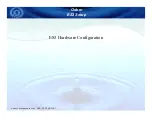
2)
If present:
Remove dirt from water drainage contours using a toothpick
and rinse.
3) Rinse the soap away with clear fresh water. In doing so, rinse the foot
shell until all dirt has been removed.
4) Dry the product with a soft cloth.
5) Allow to air dry in order to remove residual moisture.
7 Maintenance
►
A visual inspection and functional test of the prosthetic components
should be performed after the first 30 days of use.
►
Inspect the entire prosthesis for wear during normal consultations.
►
Inspect the product for visible damage every six months. Make additional
inspection appointments as needed (e.g. for highly active or heavy
users).
►
Check the condition of the functional ring as part of each inspection. If
the user frequently compresses the functional ring to the stop while
walking, or if the functional ring exhibits visible damage, replace the
functional ring (see page 24).
7.1 Replacing the functional ring
To replace the functional ring, the adapter with pyramid is removed from the
base body. The O-rings on the adapter and the mounting screw are also
replaced together with the functional ring.
>
Required
materials:
Pre-compression
kit,
torque
wrench
(e.g. 710D20), degreasing cleaner (e.g. 634A58 isopropyl alcohol), Loc
tite 243 or Loctite 246
1) Remove the footshell and the prosthetic foot from the prosthesis.
2) Insert an Allen key (
6 mm
) into the hole in the pyramid and unscrew the
mounting screw in the distal end of the base body (see fig. 6).
3) Pull the adapter with pyramid up and out of the base body (see fig. 7).
4) Remove the functional ring.
5)
If the O-rings are worn:
Remove the O-rings from the adapter (see
fig. 8).
6)
If the O-ring is worn:
Remove the O-ring from the mounting screw (see
fig. 8).
7) Clean the mounting screw and adapter including thread with degreasing
cleaner (see fig. 8).
8) Slide new O-rings onto the adapter and apply silicone grease. Make
sure that no silicone grease gets into the threads (see fig. 8).
9) Slide a new O-ring onto the mounting screw (see fig. 8).
24
















































